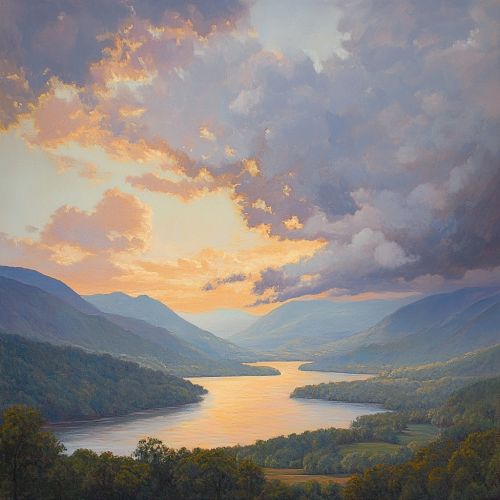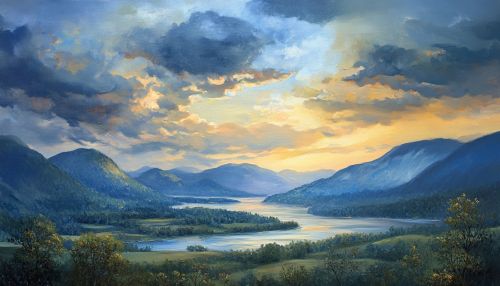Hudson River School
Introduction
The Hudson River School was a mid-19th century American art movement embodied by a group of landscape painters whose aesthetic vision was influenced by romanticism. The paintings typically depict the Hudson River Valley and the surrounding areas, including the Catskill, Adirondack, and White Mountains. The movement is characterized by its realistic, detailed, and sometimes idealized portrayal of nature, often imbued with a sense of the sublime.
Historical Context
The Hudson River School emerged during a period of significant social, political, and economic change in the United States. The early 19th century was marked by rapid industrialization, westward expansion, and a growing sense of national identity. The movement was partly a reaction to these changes, emphasizing the beauty and grandeur of the American landscape as a counterbalance to the encroaching industrialization.
Founding and Key Figures
The movement is generally considered to have been founded by Thomas Cole, who is often regarded as the father of the Hudson River School. Cole's works, such as "The Oxbow" and "The Course of Empire" series, set the tone for the movement with their grandiose and dramatic depictions of nature.
Other prominent artists associated with the Hudson River School include Asher B. Durand, Frederic Edwin Church, Albert Bierstadt, and Jasper Francis Cropsey. Each of these artists contributed to the movement's development in unique ways, but all shared a common commitment to capturing the majesty of the American landscape.


Artistic Characteristics
The Hudson River School is characterized by several distinct artistic features:
Realism and Detail
Artists of the Hudson River School were known for their meticulous attention to detail. They often spent considerable time sketching and studying their subjects in nature before beginning their paintings. This commitment to realism is evident in the intricate depictions of trees, rocks, and water in their works.
Use of Light
Light plays a crucial role in Hudson River School paintings. Artists often used light to create a sense of depth and to highlight the natural beauty of the landscape. The interplay of light and shadow, known as chiaroscuro, is a common technique in these works.
Sublime and Picturesque
The Hudson River School artists were heavily influenced by the romantic notion of the sublime, which emphasizes the awe-inspiring and sometimes terrifying aspects of nature. This is often contrasted with the picturesque, which focuses on the more serene and harmonious aspects of the landscape. Many paintings from this movement balance these two elements, creating compositions that are both beautiful and emotionally powerful.
Themes and Symbolism
The Hudson River School artists often imbued their works with deeper symbolic meanings. Common themes include:
Manifest Destiny
The concept of Manifest Destiny, the belief that the expansion of the United States across the American continents was both justified and inevitable, is a recurring theme in Hudson River School paintings. The vast, unspoiled landscapes depicted in these works often symbolize the potential and promise of the American frontier.
Nature as Divine
Many Hudson River School artists viewed nature as a manifestation of the divine. This is evident in the almost reverential way they depicted the landscape, often with a sense of awe and wonder. This spiritual connection to nature is a key element of the movement's philosophy.
Environmental Awareness
While the Hudson River School artists celebrated the beauty of the American landscape, they were also aware of the threats posed by industrialization and development. Some works subtly critique the encroachment of human activity on the natural world, highlighting the need for conservation and preservation.
Influence and Legacy
The Hudson River School had a profound impact on American art and culture. It helped to establish landscape painting as a significant genre in American art and inspired subsequent generations of artists. The movement also contributed to the development of the American conservation movement, influencing figures such as John Muir and the establishment of national parks.
Later Developments
The influence of the Hudson River School can be seen in later American art movements, such as the Luminism and the American Barbizon School. These movements continued to explore themes of nature and landscape, building on the foundations laid by the Hudson River School.
Modern Relevance
Today, the works of the Hudson River School artists are celebrated for their historical and artistic significance. They are featured in major museums and collections, and their influence can still be seen in contemporary landscape painting.
See Also
- Thomas Cole
- Asher B. Durand
- Frederic Edwin Church
- Albert Bierstadt
- Jasper Francis Cropsey
- Luminism (American art style)
- American Barbizon School
- Manifest Destiny
- John Muir
